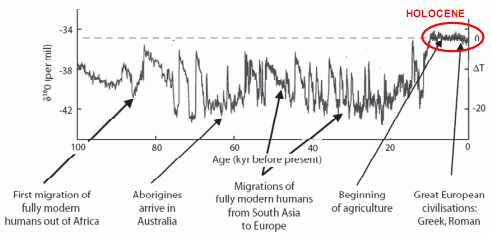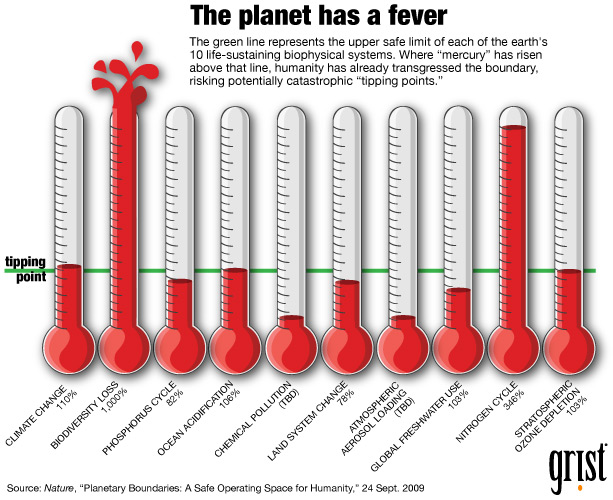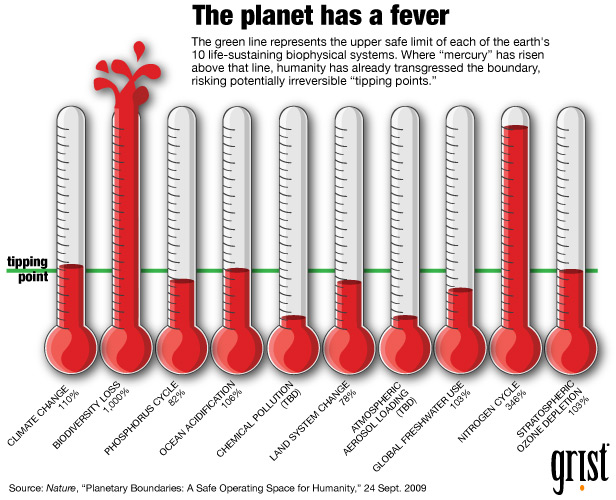It is a well-provisioned ship, this on which we sail through space. If the bread and beef above decks seem to grow scarce, we but open a hatch and there is a new supply, of which before we never dreamed.
That, from Henry George’s Progress and Poverty, is how humanity viewed the planet for most of modern history: a vessel stocked with virtually endless provisions. In the 20th century, however, our view of Spaceship Earth became more sober and more complicated. We realize now that our vessel’s provisions are finite, we are consuming at rates beyond what can be sustained, and we do not know with any precision how close we are to our limits or what happens if we cross them. “There is one outstanding important fact regarding Spaceship Earth,” said Buckminster Fuller, “and that is that no instruction book came with it.”
Now scientists have taken a first step toward creating just such a manual. In the latest issue of Nature is a groundbreaking new paper called “Planetary Boundaries: A Safe Operating Space for Humanity.” In it, a team of 28 scientists has identified 10 separate biophysical systems crucial to humanity’s flourishing; for each system they have identified a “safe operating boundary” within which humanity must remain if it wishes to maintain the basic environmental conditions in which it evolved.

The last glacial cycle of 18O (an indicator of temperature) and selected events in human history. The Holocene is the last 10,000 years. Adapted from Young and Steffen (2009).
Nature
“Human activities,” the scientists warn, “have now reached a magnitude that may trigger irreversible and in a some cases abrupt environmental change by damaging the regulatory capacity of the systems on Earth that keep the planet in the desired Holocene state.”
Here’s the bad news about those boundaries, beyond which we risk nonlinear and irreversible consequences: we’ve already transgressed three of them. Here’s the tally:
We travel together, passengers on a little spaceship, dependent on its vulnerable reserves of air and soil; all committed for our safety to its security and peace; preserved from annihilation only by the care, the work, and, I will say, the love we give our fragile craft. — Adlai Stevenson
The numbers more or less speak for themselves. If you’re interested in the details, read the full paper in Nature. I’d just make one follow-on point.
Discussion around environmental problems often suffers from what Alex Steffen terms “carbon blindness.” The carbon blind see climate change as a single, overriding, monocausal problem with a targeted solution: reducing CO2 concentrations in the atmosphere. They are susceptible to symptom-chasing solutions like geoengineering with space mirrors or sulfur clouds. But the Nature paper makes clear that as politically, intellectually, or even spiritually inconvenient as it may be, the problem we face is much larger and more systemic than carbon in the air.
There are questions humanity will have to grapple with consciously and deliberately: How can we live in a way that honors our descendents? How should we work, get around, power ourselves, feed ourselves, house ourselves? How many of us should there be? Everyone living has a stake in the answers. In times of trial, it’s useful to recall the words of Marshall McLuhan: “There are no passengers on Spaceship Earth. We are all crew.”
—–
Here is the raw data that scientists used to make their determinations about tipping points (red indicates boundary exceeded):
| Earth system process | What is being measured (units) | Proposed boundary | Today’s figure | Pre-industrial figure |
| Climate change | (i) Atmospheric carbon dioxide concentration (parts per million by volume) | 350 | 387 | 280 |
| (ii) Change in radiative forcing (watts per metre squared) | +1.0 | +1.5 | 0.0 | |
| Biodiversity loss | Extinction rate (number of species per million species per year) | 10 | >100 | 0,1-1 |
| Nitrogen cycle (part of a single biogeochemical flow boundary) | Amount of N2 removed from the atmosphere for human use (millions of tonnes) | 35 | 121 | ZERO |
| Phosphorus cycle (part of a single biogeochemical flow boundary) | Quantity of P flowing into the oceans (millions of tonnes) | 11.0 | 8.5-9.5 | ~ 1 |
| Stratospheric ozone depletion | Concentrations of O3 (DU) | 276 | 283 | 290 |
| Ocean acidification | Global mean saturation state of aragonite in surface sea water | 2.75 | 2.90 | 3.44 |
| Global freshwater use | Withdrawals of freshwater for use by humans (km3 per year) | 4000 | 2600 | 415 |
| Land system change | Percentage of global land cover converted to cropland | 15 | 11.7 | Low |
| Atmospheric aerosol loading | Overall particulate concentration in the atmosphere, on a regional basis |
To be determined |
||
| Chemical pollution | For example, amounts emitted to or concentrations of persistent organic pollutants (POPs), plastics, endocrine disruptors, heavy metals, and nuclear waste in the global environment, or effects on ecosystem and Earth System functioning thereof |
To be determined |
||




